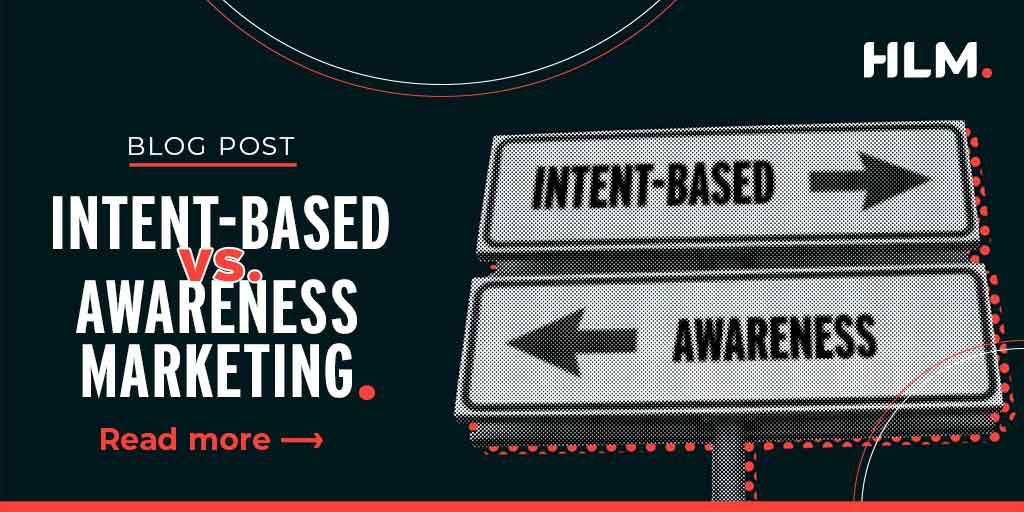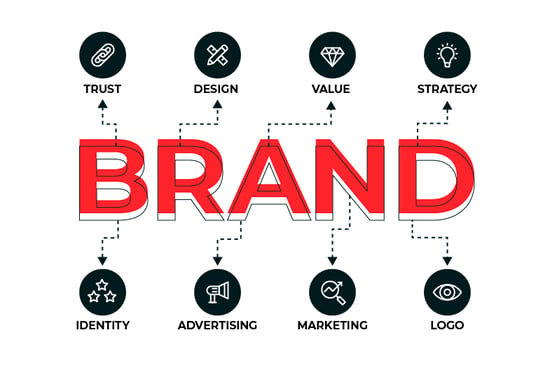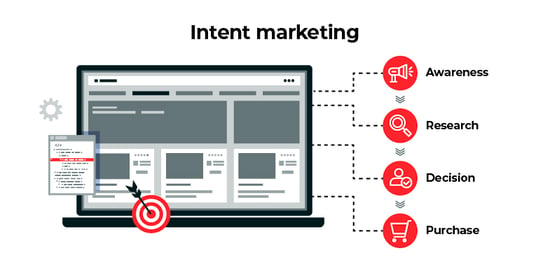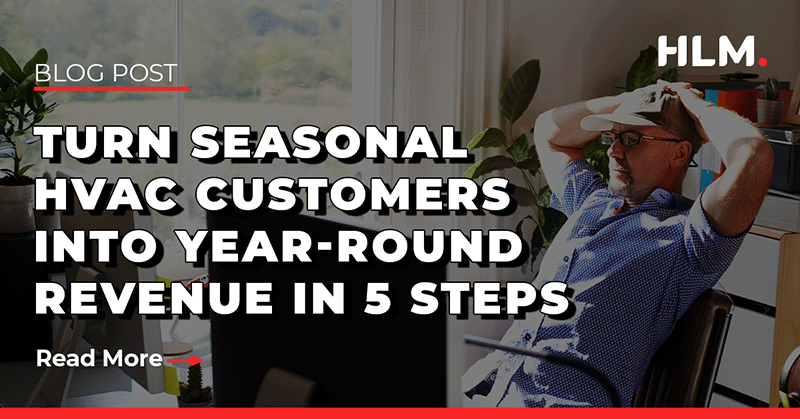![]() By Regina Marsden-Crupe
Oct 16, 2023 8:08:00 AM
By Regina Marsden-Crupe
Oct 16, 2023 8:08:00 AM

As you work to grow your business, you want to drive more customers to your website and turn them into customers. But what's the best way to do that? Should you focus on digital paid media, traditional brand awareness advertising, or other local promotional activities?
While digital marketing becomes more complicated every day, the silver lining is that we never had as much access to useful data as we do today.
Brand awareness and intent are two key components of marketing. Both play an important role in how your customers find your business and learn about your products and services. But they're not the same. When marketing your business online, it's important to understand the differences, which to use based on your business objectives, and how they affect your overall strategy.
What are the key differences between intent and awareness marketing?
Intent-based marketing and brand awareness approaches are both key facets of a company's marketing.
Intent-based marketing employs behavioral data to assemble tailor-made campaigns for users that reflect their exact requirements. Brand recognition centers on developing an emotional bond with your company, product, or services. Customer loyalty builds over time through consistent communication across all touchpoints, such as advertising, websites, or social media networks.
Although there are differences between the two strategies in terms of objectives and methods, it's beneficial to combine them when trying to build a successful campaign. Let's take a closer look.
What is brand awareness marketing?
Brand awareness marketing is designed to create a positive connection between your company and the specific type of product or service in the minds of customers. It's also about creating a positive association with your brand and establishing it as an authority on issues related to your industry. In other words, it's about people thinking, "I know who this is" when they hear your company name or see its logo or tagline.

Awareness campaigns tend to use more traditional advertising and promotional methods considered more indirect or casting a wider net. It's about getting people to recognize and remember your business so that when they're ready to buy something, they'll think of you first.
The benefits and challenges of using brand awareness marketing
Brand awareness-based marketing is a longer-term strategy that focuses on the company itself. Businesses often use it to establish their brand, build trust, create loyalty, and connect with potential customers. It can also be a good way for companies to reach new audiences who haven't heard of them before or those who need more information about the company before they make a purchase.
One challenge is that it's a broad tactic and requires time and resources for your company to determine the right mix of channels and tactics to create content so that people know about you and what you do. Another challenge is that many other businesses use the same strategy and advertising tactics. It becomes harder to differentiate messaging and cut through the “noise.”
"Intent" is about people actively searching for information about your product or service.
What’s intent-based marketing?
Companies have collected more and more data on their customers and prospects. This data gives businesses the ability to deliver more successful campaigns. In the digital marketing world, data is power. Companies with access to the data can use intent-based marketing to create higher-quality leads with better conversion rates. So, what's intent-based marketing and why is it so important?

"Intent" is when a potential client or existing customer takes online actions that demonstrate a need for a service or product that your business provides. This is also called "in-market." For example, when your air conditioner breaks in the middle of summer or you have a car accident. In both scenarios, it's fair to say that you're in the market for an air conditioner technician or an auto repair service. Intent data is a powerful tool that helps you find new customers, engage with existing customers, and offer the right message at the right time to the right person.
Intent-based marketing examines the actions behind searches. If you're looking for a particular product you want to buy, your search is likely more focused and specific than if you're just casually browsing. Intent data can help marketers identify what products or services potential customers are looking for, and which audience has the highest likelihood of converting into new leads or sales.
The important thing about using intent data for marketing is that it enables companies to tailor their strategies based on more accurate information about what each customer wants, rather than relying solely on general assumptions based on location or demographics. Research shows ads served with intent signals have a 30% higher consideration and a 40% higher purchase intent than those served with demographic signals.
The benefits and challenges of using intent data
Intent data find prospects with above-average web browsing activity on topics crucial to their business. When potential buyers have pain points, they visit websites, read articles, download ebooks, and click on digital ads; all online activities that many target database platforms track and curate weekly. With this data, prospects can be identified at the earliest stage of their purchasing journey, perhaps even before they have engaged in sales or marketing channels.
For example, you could identify a customer who is likely to buy your product or service based on their past behavior. However, if they don't yet know about your business and aren't looking for it at the time when they are ready to buy something similar, knowing that this information will only help them find you in search results after they have already made their purchase elsewhere; that's too late!
The solution? Make sure your targeted marketing strategies are visible across all channels so that customers see them when they need them most.
The benefits of using intent data are numerous, but they can also present challenges. With the increase in machine learning, artificial intelligence (AI), and search engine algorithms, data collection happens almost everywhere. But where and how do you get the data? The availability of targeted database technology platforms that you can invest in has also increased. If you're not sure how and why you'll incorporate intent data, it will be difficult to assess which platform will be best for your business and most cost-effective. And these platforms are a significant investment in time and money. The costs can be quite high, and you'll have to devote tremendous amounts of time to learning how to use the platform but also to identify, map, build reports, and then use the data. Complicating matters is the rapid change that is occurring within the search ecosystem with the display of results and multiple algorithm chanages that have occurred in 2023.
How do you know when to use one strategy over the other?
Understanding how to use both intent data and brand awareness marketing as part of your marketing strategy is an important step toward building your online visibility and achieving success in lead generation. A successful marketing strategy involves combining intent data and brand awareness.
Both strategies can be used together for stronger campaign results. By combining both intent data and brand awareness tactics, you can build trust with your customers, promote your product or service, and capture sales through paid advertising and search engine optimization.
In this short video, HLM digital marketing expert, Jake Evans explains:
- Which digital marketing tactics to use to get your business in front of people who want to buy?
- Which digital marketing tactics are good for raising brand awareness?
- Which you should invest in to meet your business goals?
So, which is best?
Although brand awareness and intent are two very different types of marketing strategies, they can be effectively combined to form a stronger campaign. When choosing which type of marketing approach to use, you should first evaluate your objectives and familiarize yourself with the data available to determine which method works best for your available resources and marketing budget. Investing in both, you can reach your prospects and target customers at both ends of the buying spectrum.
But if your overall goal is to bring in more leads and business fairly quickly, focus on tactics such as paid ads and search engine optimization, where you are targeting people who demonstrate an immediate intent to buy.
Need help with capturing in-market prospects with intent data? Don’t go it alone!
Book your complimentary digital marketing consultation with Jake:
Get Started →
The article was originally posted on November 22, 2023, and has been updated and republished on October 16, 2023<
Author: Regina Marsden-Crupe
Contact Us NowRecent Posts
When you're done with this post, check out our other content below for more Digital Marketing expertise
Contact Us Today
Complete the form below and receive a call within minutes.
Need faster results? Call us now at (888) 717-4249





